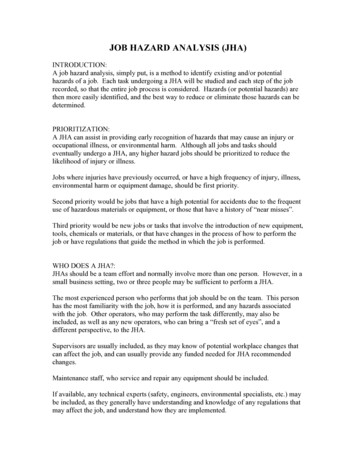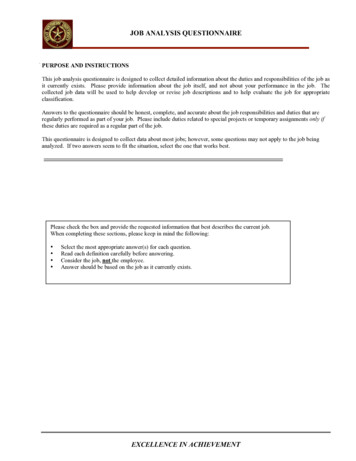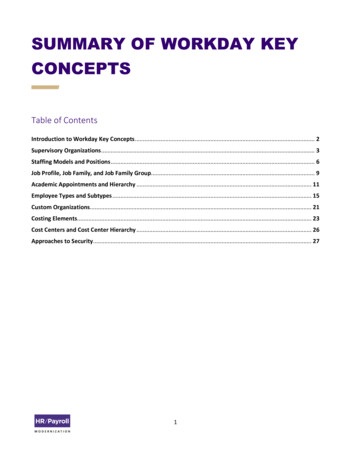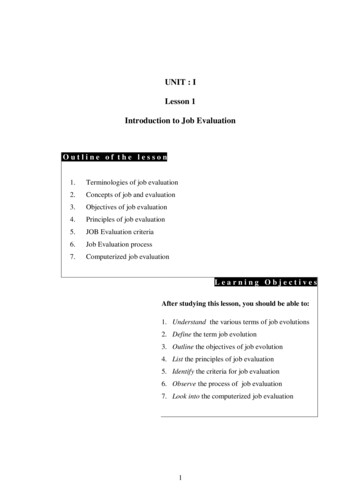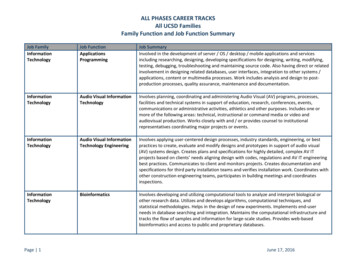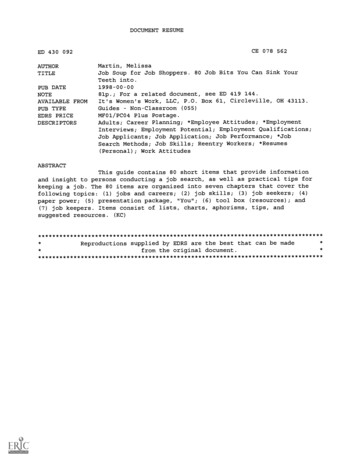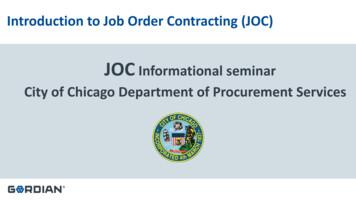
Transcription
Introduction to Job Order Contracting (JOC)JOC Informational seminarCity of Chicago Department of Procurement Services
Agenda1. Overview of Job Order Contracting (JOC)2. Bidding as a Prime Contractor3. Job Order Contracting (JOC) Process4. Benefits to JOC1. Prime Contractors2. Subcontractors5. Review/Key Points6. Open Discussion (Q&A)
Overview of Job Order Contracting JOC is part of the family of indefinite quantity contracts: JOC, WOC, DOC, SABER,IDIQ, and IQC. The Federal Government began using JOC in the mid-1980’s as a delivery methodfor small to medium sized construction work. The Gordian Group was established in 1990 for the purpose of implementing JOCfor non-Federal agencies such as the City of Chicago. Today, there are over 2,000 Job Order Contracts in use nationwide with over 1.8billion of construction ordered annually. In 2005, the National Institute of Governmental Purchasing (NIGP) awarded the“Best of the Best” award to City of Miami Beach for their implementation of a JOCprogram and the subsequent efficiencies that came out of having a JOC program. In 2015, Cook County received a National Association of Counties (NACo) awardfor their use of Job Order Contracting.
Overview of Job Order ContractingJOC is another delivery method for the City to procure construction services In-House Trades Traditional Bid Term Agreements Job Order Contracting (JOC)JOC is not meant to replace any procurement method - it is another tool for the City to accomplish work.
Overview of Job Order ContractingJob Order Contracts are: Firm, fixed price, competitively bid, indefinitequantity, delivery method designed to produce a large number of multitraded, repair and rehabilitation projects, as well as minor new constructionprojects quickly. Firm, Fixed Price: Construction Task Catalog of pre-priced work tasks. Competitively Bid: all bidders submit a set of adjustment factors to the fixedprices in the Construction Task Catalog . Indefinite Quantity: no projects are identified at the time of bidding.Contract is for a fixed term and has potential maximum dollar value. Once the master (umbrella) contract is awarded, Job Orders are issued forindividual projects, potentially up to the maximum value of the contract.
Overview of Job Order ContractingPrime ContractorsPrime & Subcontractors
Part 1 - Bidding as a Prime Contractor Book 1: Instructions to Biddersand Execution DocumentsBook 2: City’s General Conditionsand JOC Special ConditionsBook 3: Construction TaskCatalog Book 4: Technical SpecificationsBook 5: Clients’ SpecificationsGordian Documents
Construction Task Catalog (CTC)Book 3: Construction Task Catalog (CTC) (CD-ROM) Catalog of pre-priced construction tasks Organized by CSI MasterFormat Prices include local labor, equipment and material (LEM) costs Customized for City’s tasks and standards
Technical SpecificationsBook 4: Technical Specifications Coordinated Construction Task Catalog and Technical Specifications gives bidders confidence in thepricing structure of the JOC process.CRITICAL POINT! To realize optimum savings and control, it is essential that each construction task be tied to aconcise technical specification.
Bidding as a Prime ContractorStep 1: Determine direct costs Analyze the CTC and specifications Completeness and clarity Review the CTC price against direct cost for accomplishing the work Prices in the CTC do not include subcontractor OH & P Do you have to increase prices to cover your direct costs? Depends on amount of self performance versus subcontractingStep 2: Determine overhead costs & profit expectations Bonding, insurance, etc. Main overhead is staffing How much will it cost to employ the required staff?Step 3: Bid normal hours and other than normal hours factors to the prices quoted in the CTC Applied to all work tasks in the CTC Must cover direct costs, overhead and profit Cannot exclude any tasksStep 4: Specify EEO commitments and determine the award criteria figure The bid forms will walk bidders through the calculationsLow bidder is based on the lowest award criteria figure.
Bidding as a Prime ContractorPreferred method for analyzing the price in the CTC versus your costs Select a comparable project from your files (more than one)– Example: The project you selected paid you 82,323.00– You were happy with 82,323.00 Build a price proposal from the CTC at a factor of 1.0000 (i.e., no adjustment)– Price from the CTC 75,746.00 Calculate the adjustment factor– If you were satisfied with the 82,323.00 (i.e., covers your direct costs, OH &profit)– You would need an adjustment factor of: ( 82,323.00 / 75,746.00) 1.0868Dollar amounts and adjustment factor used above are for examplepurposes only.
Bidding as a Prime ContractorExample of an Excel spreadsheet used to analyze pricing
Bidding as a Prime ContractorDon’t Stop There – Select More Than One Project! Projects of varying scope Single trade projects and multi-trade projects Interior renovations Projects of varying size 35,000.00 project 150,000.00 project Other methods Evaluate a sampling of the anticipated items Get subcontractors to evaluate their section of the CTC
Bidding as a Prime ContractorTips for being a successful JOC Contractor Bid correctly– Anticipate the type of work the City expects to complete using JOC– Depends on the contract.– At the pre-bid meeting, there are four (4) slides detailing the type of work used underthe previous JOC contract.– Analyze the prices in the CTC versus your costs– Run sample projects.– Determine factors required to adjust prices in CTC to cover your direct costs,overhead, and profit. Staff correctlyThe bid factors and quality of staff affect whether or not a contractor can meet theperformance standards
Part 2 - The JOC Process
The JOC Process Department develops SOW Create JOC job order in eGordian Notifies JOC Contractor of new Project – Forwards scope Finalize outstanding issues at Joint Scope meeting Develop Scope of Work Request for Proposal Contractor develops proposal Selects tasks and quantities from CTC Submits to the City for reviewChange orders &hidden conditionsfollow the samefixed priceprocess Contractor’s proposal reviewed & approved Contractor prepares final package Includes a list of subcontractors, M/WBE status, and certification letters Issue lump sum blanket releaseFrom DPSapproval toissuance ofblanket release isapproximately 3545 days.
Performance BasedJob Order Contracts are a performance based contracting system. Once a minimum value is reached,future work is dependent upon contractor performance Responsiveness of the contractor Performance is rated from the project development phase through construction—start-up to closeout Project development phase Scope definition Timely and accurate price proposals Construction phase Timely start-up Effective management of work crew, to include subcontractors Ensuring project is constructed according to the specifications Success in developing a partnership relationship with owner Performance also depends on: Accurate adjustment factor Quality staff
Performance BasedJOC contracts include measurable performance standards Quality Price Proposals: accurate price proposals that can be approved on the first or secondsubmission. Timely Price Proposals: timely price proposals that are submitted on or before the due dateindicated on the Request for Proposal. Timely Construction: rapid mobilization to start work, adherence to the agreed uponconstruction schedule and timely completion of any punch list items. Quality Construction: good quality construction where projects are constructed according to thespecifications and require minimal punch list items. Achievement of M/WBE Goals: meet or exceed the M/WBE goals set forth in the contractdocuments. Achievement of Self Performance Goals: meet or exceed the self performance goals set forth inthe contract documents.
Benefits in Job Order ContractingPrime Contractor’s benefits with Job Order Contracting JOC can be profitable Profit is a function of volume Volume is driven by performance JOC provides a steady flow of work Do not have to chase the next project Long-term relationship with the City Non-adversarial relationship Develop partnership with the City Professionally rewarding Different types of projects (varying scope) Ability to provide input during scope development
Benefits in Job Order ContractingSubcontractor’s benefits with Job Order Contracting No projects are identified at the time of bidding, so Prime Contractor cannot staff up to selfperform. Increased subcontracting opportunities because Prime Contractors must utilize subcontractingcommunity. Simplified procurement process for the City allowing them to procure more work in a shorterperiod of time. Multiple projects on multiple sites simultaneously.
Benefits in Job Order ContractingContact Prime Contractors and establish a relationship.Variety of methods for Subcontractors to provide a quote: Provide a lump sum quote Provide a lump sum quote with a material breakdown Provide a lump sum quote with a material breakdown and CSI numbers from CTCSubcontractors are NOT bound to the prices in the CTCAs contracts are advertised, it may be worthwhile to obtain a copy of the CTCso you know what Prime Contractors are being paid for a specific work task.JOC is a performance based contracting system that requires high qualityconstruction.
Review/Key points JOC is an established procurement system used by several types of public agenciesnationwide. JOC has benefits for all parties: Owner, Prime Contractor, & Subcontractors. Performance based contracting system that determines the amount of work to beissued. For Subcontractors, be aware of the methods to submit a quote to the JOC PrimeContractor and be ready to perform at a high level.
Getting Involved!Getting involved in the JOC program Analyze the JOC programs in the Chicago area and any other areas youare willing to work. Identify those programs whose Scope of Work relates to your work. For Prime Contractors, analyze the prices in the CTC and developaccurate adjustment factors at the time of bidding. For Subcontractors, establish a relationship with Prime Contractors.
Review/Key points City of Chicago Departments with a JOC ProgramDepartment of Fleet and Facility Management (2FM)Department of Aviation (CDA)Department of Water Management (DWM)Department of Planning and Development (DPD)Department of Fleet and Facility Management Environment (DOE)Office of Emergency Management and Communications (OEMC)Department of Transportation (CDOT)
Review/Key points Identification of other agency's JOCprograms is for informationalpurposes only.All discussions in this workshoppertain to the City of Chicago only.Procedures at other agenciesidentified on this slide may bedifferent.To find advertisements for agencieslisted on this slide, look on theagency’s website.The City’s website does not advertisecontracts for agencies listed on thisslide. Chicagoland Area JOC ProgramsChicago Housing AuthorityChicago Public SchoolsChicago Transit AuthorityPublic Building CommissionCity Colleges of ChicagoUniversity of Illinois at ChicagoCook CountyLake CountyNapervilleUnited States Postal Service
To Find More Information .To find out about current advertisements (applies to all City contracts) Sign up for DPS alerts See postcard inside the handout Check the DPS website Go to www.cityofchicago.org/procurement Under Bid Proposal Information, click on the link for “Current Bids andRequests for Proposal” Check the newspaper (Chicago Sun Times)
Key ContactsCity of Chicago Contracting ProcessJob Order Contracting ProcessJob Order Contracting ProcessByron WhittakerMichael BatchmanMichael JuddAssistant Deputy Procurement OfficerSenior Account ManagerAccount ManagerThe City of ChicagoThe Gordian GroupThe Gordian Groupe: Byron.whittaker@cityofchicago.orge: m.batchman@gordian.come: m.judd@gordian.comp: 312.744.4926p: 312.882.8697p: 312.489.7277
Questions28
Provide a lump sum quote with a material breakdown and CSI numbers from CTC Subcontractors are NOT bound to the prices in the CTC As contracts are advertised, it may be worthwhile to obtain a copy of the CTC so you know what Prime Contractors are being paid for a specific work task.

